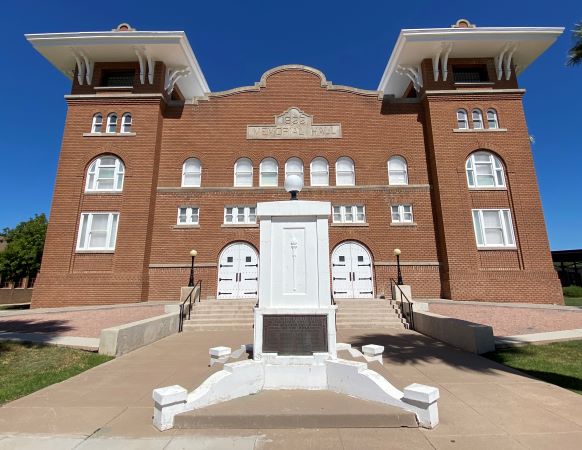apartmentApply to Osborn Pointe! Learn more about this 55+ community in Phoenix - NOW LEASING!

When the first World War broke out in 1914 hundreds of young men enlisted, including Native American boys from the Phoenix Indian Industrial School. Though, at the time, Native Americans were not yet citizens of the United States.
The school opened in 1891 and was operated by the federal government in order to assimilate Native American children. The federal boarding school policy created dozens of such schools across the country. These boarding schools were operated like military bases where the children wore uniforms and marched from the dorms to the dining hall and to the classrooms.
When the call to serve their country came, the boys were ready. 62 boys from Phoenix Indian served in the war. Two of them were killed in action.
When the war ended, the federal government gave permission for a building to be constructed to honor these boys. In 1922, Memorial Hall was completed. It is a tribute to the boys who served. In front of Memorial Hall is a bronze plaque which has the names of each student who served. Two years later, in 1924, Congress passed the Indian Citizenship Act.
Today Memorial Hall is located inside of Steele Indian School Park, located at 300 E. Indian School Road.
This year marks the 100th anniversary of the building of Memorial Hall in Phoenix. A special commemoration program will take place inside Memorial Hall on Saturday, October 8, 2022. The program will begin at Noon with special musical guests and a reading of the names of the boys who served. The public is invited to attend this free event. If you would like more information about this event you can call: 602-534-8659.
In addition to the program at noon, the day will start with a parade at 9 a.m. on 3rd Street and Oak. This is Native American Connections 38th Annual parade, a major event of Native American Recognition Days activities held each year," said Diana Yazzie Devine, CEO of Native American Connection.
"This year is especially important because not only are we honoring the former students who served in the military from the Phoenix Indian School, we are also celebrating the 50th Anniversary of Native American Connections and the 75th Anniversary of the Phoenix Indian Center and their service to the Community,” added Devine.
Tours will be held inside the Phoenix Indian School Visitor Center, which once served as the elementary school and later, the music building for Phoenix Indian. A special showing of a 30-minute documentary about the P.I. marching band will also be screened. In 1983 the band traveled to Washington, D.C. to march in the Fourth of July parade. They also placed wreaths at the Tomb of the Unknown Soldier and the Iwo Jima Memorial. One of the flag raisers at Iwo Jima was Ira Hayes, a graduate of Phoenix Indian School. For information on the parade and tours at the Phoenix Indian School Visitor Center you can call: 602-254-3247.
The day will be capped off by a pow wow at Steele Indian School Park. "We hope to see many alumni from the Indian School come to our events," said Devine.
For information about the pow wow, please call the Phoenix Indian Center at 602-264-6768.
Our traditions are the foundation of our organization - explore, learn, and utilize resources available for all.

Get the support you need with health, housing, and community services available at Native American Connections.

Your support changes lives and builds healthy communities. Find ways to get involved.

A "chronically homeless" individual is defined to mean a homeless individual with a disability who lives either in a place not meant for human habitation, a safe haven, or in an emergency shelter or in an institutional care facility if the individual has been living in the facility for fewer than ninety (90) days and had been living in a place not meant for human habitation, a safe haven or in an emergency shelter immediately before entering the institutional care facility. In order to meet the ‘‘chronically homeless’’ definition, the individual also must have been living as described above continuously for at least twelve (12) months or on at least four (4) separate occasions in the last three (3) years, where the combined occasions total a length of time of at least twelve (12) months. Each period separating the occasions must include at least seven (7) nights of living in a situation other than a place not meant for human habitation, in an emergency shelter or in a safe haven.
Federal nondiscrimination laws define a person with a disability to include any (1) individual with a physical or mental impairment that substantially limits one or more major life activities; (2) individual with a record of such impairment; or (3) individual who is regarded as having such an impairment. In general, a physical or mental impairment includes, but is not limited to, examples of conditions such as orthopedic, visual, speech and hearing impairments, cerebral palsy, autism, epilepsy, muscular dystrophy, multiple sclerosis, cancer, heart disease, diabetes, Human Immunodeficiency Virus (HIV), developmental disabilities, mental illness, drug addiction, and alcoholism.